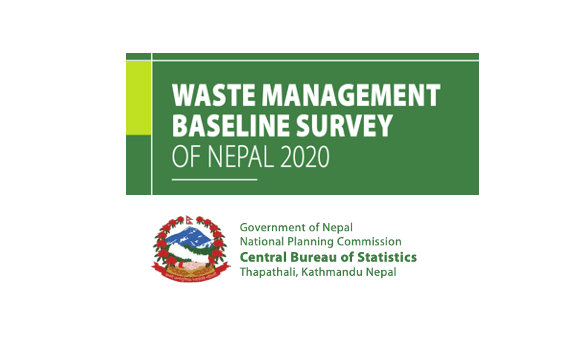Central Bureau of Statistics (CBS) conducted the waste management baseline survey in 2019/20 and has covered 271 municipalities of Nepal. The major objective of the survey is to generate the baseline data and information on solid waste management including the quantity and composition of municipal solid waste and other vital information about the state of solid waste management in different urban municipalities of Nepal.
The main objective of this study was deriving systematic and comprehensive data and information on state of solid waste management (SWM), including the categorization of quantity and composition of the municipal solid waste (MSW) collected by the municipalities, executed this waste management baseline survey in the municipalities of Nepal.
Key findings
- The survey found the overall average human resource available in the municipalities to be 114 per municipality, with the higher number (477) in the metropolitan cities and the lower (99) in the municipalities.
- The average number of human resources assigned for waste management was 118 per metropolitan city, followed by 59 and 12 in the sub-metropolitan cities and municipalities, respectively.
- The survey revealed very limited technical human resources in the municipalities.
- The survey revealed three broad categories of wastes generated from the municipalities. These were: organic waste, inorganic waste and other waste.
- The organic waste mainly consists of paper, textile and agricultural waste; whereas inorganic waste comprised of plastic, glass, rubber, metals and minerals; and other wastes composed of waste that were not included in either of these two categories.
- The annual average total waste collected per municipality amounted to 2231.0 mt in 2073/74, 2164.4.0 mt in 2074/75 and 2232.7 mt in 2075/76. These figures convert to an average daily waste collection per municipality equals to 6.1 mt, 5.9 mt and 6.1 mt, respectively for the three years.
- By waste type, the organic waste accounted for higher share compared to the inorganic and other wastes. The organic waste composition was highest (54.0%) in 2075/76 compared to the inorganic waste (33.3%) and other wastes (12.7%).
- The municipal waste is generated from varied sources such as households, institutions, business/commercial complex, hospitals, etc.
- Among the metropolitan cities, the quantity of daily waste collection was highest in the household (15900 kg/day), followed by business complex (7700 kg/day) and the educational institutes (4680 kg/day).
- Similarly, the households remained the major sources of waste generation in the sub-metropolitan cities (3300 kg/day) and municipalities (1440 kg/day).
- The highest coverage was made by the metropolitan cities in terms of wards, households and population coverage mainly because of their higher capacities in all respects.
- Considering coverage with respect to the ecological zones, municipalities of Terai region reported higher waste collection coverage, followed by the hill and mountain regions.
- The capacity of waste transfer stations was 10000 cu. m for the metropolitan city and lower for the sub-metropolitan cities and municipalities.
- Among the municipalities, only 5 municipalities (1 metropolitan city, 1 sub-metropolitan city and 3 municipalities) were having weighing machine for recording weight of waste at the transfer station.
- A total of 232 (85.6%) municipalities reported at least one or other type of means of transportation for transporting waste.
- The survey revealed different waste handling practices adopted by the municipalities. The three main methods of waste handling were, i) piling up in landfill site by 48.6%, ii) burning by 32.1%, and iii) piling up in the river side by 27.4%.
- The survey revealed varied distances of landfill sites with different categories of the municipalities. The average distance of landfill sites was 4.3 km, with the higher average distance (17.5 km) among the metropolitan cities as compared to 4.4 km among the sub-metropolitan cities and 4.0 km among the municipalities.
- Among the total (271) municipalities surveyed, 149 (55%) municipalities have prepared their plans which were the basis to implement the waste management activities.
- In the present governance structure, waste management is largely the responsibility of the local governments. For the solid waste management, the local governments require adequate resources like human and financial resources.
It is expected that waste generation is likely to increase in the years to come and Nepal might face substantial challenge in managing these wastes with the existing waste management mechanisms. The government therefore needs to develop effective waste handling procedures and strengthen institutional mechanisms to respond solid waste management challenges. Moreover, there is also need to strengthen the capacity of the municipalities in waste data handling and management.
[Excerpt from executive summary]

Health Care Waste Management Guideline
Waste Management Baseline Survey of Nepal 2020
Central Bureau of Statistics (CBS) conducted the waste management baseline survey in 2019/20 and has covered 271 municipalities of Nepal. The major objective of the survey is to generate the…
Do you have a website? Looking for the best hosting provider? Here’s a discount code.
Latest Public Health Jobs
Latest Posts
- The Belém Health Action Plan for the Adaptation of the Health Sector to Climate Change
- Registration Now Open: Delivering for Nutrition in South Asia 2025 – Towards Impact at Scale!
- World Chronic Obstructive Lung Disease (COPD) Day 2025: Short of Breath, Think COPD!
- Global Tuberculosis Report 2025
- Postdoctoral Fellowship
Thanks for visiting us.
Disclaimer: The resources, documents, guidelines, and information on this blog have been collected from various sources and are intended for informational purposes only. Information published on or through this website and affiliated social media channels does not represent the intention, plan, or strategies of an organization that the initiator is associated with in a professional or personal capacity, unless explicitly indicated.
If you have any complaints, information, or suggestions about the content published on Public Health Update, please feel free to contact us at blog.publichealthupdate@gmail.com.
#StayUpdated



